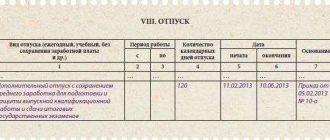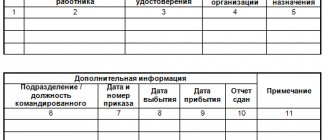MANDATORY PERSONNEL DOCUMENTS and STORAGE TIMES OF HR DOCUMENTS
Attention should be paid to the conflict that has arisen in connection with these changes. According to Art. 3 of the above Law, absolutely all information on personnel refers to archival documents reflecting the labor relationship of the employee with the employer. However, no new changes were included in the List approved by Order No. 558. In this regard, disagreements arose. If disputes arise, we recommend that you follow the Federal Law of October 22, 2004 N 125-FZ “On Archival Affairs in the Russian Federation”, because it will have greater legal force.
It follows that journal maintenance should be carried out by one person at a time. With a large number of correspondence, this process is very labor-intensive.
Will be stored on electronic media. To create and maintain, you can use, for example, office programs Word or Excel. The template is developed once and then copied. Does not require the employee to have in-depth computer knowledge.
Regulatory framework When starting work on determining the storage periods for documents, first of all, familiarize yourself with the current legislation: federal and regional laws and other regulatory legal acts that indicate the storage periods for documents regulating the scope of your activity. As for the “rules for everyone,” the storage periods for correspondence are fixed in standard lists.
Working with outgoing and internal data
When sending an outgoing letter to the addressee, registration forms are also used. They are in many ways similar to the sheets used when processing incoming correspondence. However, other information must be included here:
- outgoing number;
- name of the institution that created this document;
- date of documentation generation;
- company name or addressee name;
- surname and initials of the performer;
- approximately the date the document will be sent;
- content (abbreviated);
- case number.
Sheet count information may be added on an optional basis. Registration of outgoing papers is carried out at the site through which any correspondence is sent. This process is carried out in a decentralized manner. The departments where the creation and execution of papers takes place (office, accounting, human resources department) are responsible for it. It is necessary to record the receipt of internal documentation on the same day when the manager signed and approved it.
Independent numbering is provided for reports, contracts, instructions and orders. Letters may be added to the serial number. The use of a rational registration system ensures a modern flow of information into the office work service. Accordingly, employees can perform all key tasks without failures and monitor the timely execution of management orders.
Storage period for incoming correspondence log
Magazine graphs may vary depending on the printing house. Choose one that takes into account all the requirements of your office work or order a magazine with your columns from the printing house.
For example, in the current year, a tax audit may be scheduled to verify the completeness and correctness of tax payments for the three previous years. Therefore, throughout 2012, it is necessary to store documents relating to 2011, 2010 and 2009.
Which personnel documents must be completed, and which ones will be useful under certain conditions, see the table below.
The new List retains only the “General Provisions” section describing the structure of the document. The exception to Section 3 of the Guidelines is understandable, because
Types of citizens' appeals and their features
In accordance with the Constitution of the Russian Federation and Federal Law No. 59-FZ dated May 2, 2006, all citizens of the Russian Federation have the right to apply personally, as well as send individual and collective appeals to state bodies, local government bodies and officials who, within their competence, are obliged to consider these appeals, make decisions on them and give a reasoned response within the prescribed period.
A citizen's appeal is a complex concept. It can be a proposal, statement or complaint, as well as an oral appeal from a citizen to a state body, local government body or official, drawn up in writing or in the form of an electronic document. There are three main types of appeals: proposal, application and complaint.
A proposal is a citizen’s recommendation for improving laws and other regulatory legal acts, the activities of state bodies and local governments, developing public relations, improving socio-economic and other areas of activity of the state and society. The purpose of this type of appeal is to draw attention to the need to improve the work of certain government bodies, enterprises, institutions or public organizations, as well as to propose specific ways and means of solving the tasks.
Application - a citizen’s request for assistance in the implementation of his constitutional rights and freedoms or the constitutional rights and freedoms of other persons, or a message about violations of laws and other regulatory legal acts, shortcomings in the work of state bodies, local governments and officials, or criticism of the activities of these bodies and officials. Unlike a proposal, the statement does not reveal ways or propose methods for solving the tasks.
A complaint is a citizen’s request for restoration or protection of his violated rights, freedoms or legitimate interests or the rights, freedoms or legitimate interests of other persons. The complaint contains not only information about the violation of subjective rights and a request for their restoration, but also criticism of state or public bodies, enterprises, institutions, organizations, officials and individual citizens, as a result of whose unreasonable actions or unreasonable refusal to perform those provided for by law actions occurred, in the opinion of the applicant, a violation of his subjective rights.
In many cases, proposals, statements and complaints have a clearly defined type of citizen appeal, but often there are appeals that are of a mixed nature.
In recent years, another type of citizen appeal has been introduced - a petition, which is a citizen’s appeal, submitted in writing, with a request for recognition of a certain status, rights, guarantees and benefits with the presentation of documents confirming them. This type of appeal is issued in cases established by the legislation of the Russian Federation. It is important that the application and all documents attached to it are drawn up in accordance with the established requirements.
The Moscow Law of July 18, 1997 No. 25 (as amended on June 21, 2000 No. 21) “On Citizens’ Appeals” gives concepts such as collective appeal and its type, petition.
Collective appeals are an appeal from two or more citizens in writing containing a private interest, or an appeal adopted at a rally, meeting and signed by the organizers and (or) participants of the rally or meeting, which is of a public nature.
A petition is a collective appeal of citizens to city authorities about the need for public reforms or partial changes in city legislation.
Storage periods for outgoing and incoming correspondence
The formation of cases should be understood as the grouping of executed documents into cases (folders) in accordance with the nomenclature of cases.
The provisions establishing the storage periods for documents related to business trips have been clarified. In a response to a letter, the index details are arranged in the reverse order: for example, in number 08-11/144, the first is the digital index of the structural unit - 08, then, separated by a hyphen, the case number according to the nomenclature - 11, from which the serial number of the document is separated by a slash - 144.
The discrepant numbers of documents located in this folder should not confuse you; the main thing here is chronology, so that the documents in this folder follow one after another strictly by date. The liquidator, believe me, will curse you with his last words.
In this case, when determining the storage period, it is necessary to determine which category the document belongs to (the List establishes 12 categories).
Internal documents are often registered decentralized into groups in those departments where they are created and executed: accounting, human resources, office, etc. Internal documents must be registered on the day of signing or approval.
The list of registered and non-registered documents can be fixed in the internal documents of the organization, for example, in the instructions for personnel records management.
All correspondence received by organizations must be “posted” in accordance with the office work rules adopted by them. Incoming documents, regardless of their delivery method, are sorted, registered and transmitted to internal recipients by the person responsible for receiving mail.
Documents are recorded regardless of the method of their delivery, transmission or creation. That is, you need to register not only traditional paper documents, but also those received by fax, email and other communication channels.
The more letters an organization writes and receives, the sooner it needs to get rid of this habit, and it is better to formulate affairs with correspondence on the “request-response” principle from the very beginning.
The most convenient form of registration for automated accounting is filling out information for each document in a separate window.
The regulations on the work of such a commission, as a rule, are developed on the basis of the order of the Federal Archive of January 19, 1995 No. 2 “On approval of the approximate regulations on the permanent expert commission of an institution, organization, enterprise.”
Some organizations, in order to avoid unnecessary labor costs, approve lists of documents that do not require a mark in the correspondence book.
Every company processes a ton of incoming business documentation every day. To ensure that documents do not get lost and responsible persons can receive a delivery mark, they keep a log of incoming letters. The letters themselves are kept in the organization.
Some of these documents can be classified as permanent retention periods. When setting shortened storage periods for certain types of incoming documentation, remember: incoming letters from government authorities must be stored for at least 5 years. Sometimes correspondence with certain authorities may require filing several cases.
The storage period for incoming and outgoing correspondence is determined depending on the importance of a particular letter.
According to paragraph. Correspondence between structural divisions of the organization, with the exception of geographically remote divisions, is prohibited. Why is it so important to form this correspondence correctly?
Receives, in accordance with the resolution of the Manager, a document for its further execution, organizes the work of co-executors, and reports to the Controller on the progress of execution of the document. Receives, in accordance with the Manager’s resolution, a document for its further execution, reports to the Manager or Controller on the progress of execution of instructions under the document.
Incoming documents
It is not difficult to determine which documents are incoming - this is correspondence received by the organization from any external sources, including by email. Registration of such securities is carried out centrally. They are stamped “Incoming No...”. In a small organization, the secretary is responsible for this work. It is carried out in companies that have an office. This is the name of the department where a group of employees works who monitor the volume of incoming correspondence. A registration form is created in which all information about it is entered:
- receipt date;
- incoming number;
- the correspondent from whom the document was received;
- date indicated by the institution or the author;
- registration index;
- a title indicating the contents of the document;
- period of execution;
- the person who will process the document;
- case number.
The registration form is initially not completely filled out. First, the document must be registered; for this, a mark is placed on its receipt by the organization. It goes through initial sorting.
Until the documentation is registered and handed over to the owner of the institution, the deadline for execution, the resolution and the name of the executor cannot be written in it. All this is indicated after the manager reviews the received papers. As execution progresses, the case number and information about what stage the process is at are written down.
The registration form is a card in A5 or A6 format. It should be made of thick paper. Enterprises use cards of different colors. They may have multi-colored stripes located diagonally or at the top.
If the work is carried out using an automated system, you can display the card form on the screen and enter information as if it were done by hand. The automated system is convenient in that information can be supplemented. For example, you can designate:
- number of sheets in the application and document;
- type of document;
- location of the author who sent it;
- related documentation;
- name of the department that sent the document.
The electronic registration form contains fields that must be filled in manually correctly and according to the sample. There is also data here that can be selected from drop-down lists by selecting suitable information. This approach to entering information significantly reduces the time it takes to fill out a card. In addition, its advantage is the absence of discrepancies and typos, which may cause difficulties in the future. Any information can be searched automatically.
https://youtu.be/K5mP2d-WNzI
How many years are incoming and outgoing correspondence stored?
Registration has three purposes:
- document accounting;
- control over their implementation;
- reference work on documents.
List of standard administrative archival documents generated in the process of activities of state bodies, local governments and organizations, indicating their storage periods, approved.
How to sue bailiffs: algorithm of work Challenge the decisions, actions and inactions of the bailiff. Release property from seizure. Claim damages. This recommendation contains everything you need: a clear algorithm, a selection of judicial practice and ready-made sample complaints.
The organization keeps a log of outgoing documents, a log of incoming documents, the logs are stapled, they are not stitched, not numbered and not signed and sealed by the director of the organization, we buy these logs at an office supply store.
Journal form The journal system is usually used when document recording comes to the fore; the most valuable documents, such as passports, work books, and education documents, are usually recorded in journals.
Registration of incoming and outgoing documentation (letters, telegrams, statements, certificates, notifications, etc.) is carried out in any organization; this is an integral component of any document flow. To register documents, a special journal is created, which records data on incoming and outgoing correspondence.
A question like this: does a clerk need a fountain pen? A folder is a type of stationery. This could be: 1) a cover, 2) an envelope for storing papers, 3) a binder. Whether it is needed for office work depends on the way in which incoming documentation is stored. To summarize all that has been said, in conclusion the advice is as follows: it is most advisable to register incoming correspondence in an electronic document management system. If its installation and implementation is not available to the organization for some reason (for example, financial), then it is worth giving preference to an electronic journal in Word or Excel format.
Form N 1 JOURNAL OF INCOMING CORRESPONDENCE
The company's management reviews the telegrams and, if necessary, resolves the issues identified in them. The recipient uses a form or journal to transfer the text of the telegram.
The list of cases of a structural unit is compiled by the person responsible for record keeping, agreed with the archive and the preschool educational institution service, signed by the head of the unit and submitted to the preschool educational institution service. The newly created unit is obliged to develop a nomenclature of the unit’s affairs within a month and submit it to the preschool educational institution service.
For this type of registration of incoming documents, a simple paper journal was initially used. Regulatory legal acts relating to office work do not establish its specific form, thus giving each organization freedom of action. The company also decides in which journals and what type of documents will be recorded.
Storage period for outgoing and incoming correspondence
The reference information provides the storage periods for the most common documents of organizations, established by the List of standard management archival documents, approved. Order of the Ministry of Culture of Russia dated August 25, 2010 N 558, as well as storage periods for documents not included in the above lists and established by federal laws and other regulatory legal acts of the Russian Federation.
Cash documents and books, bank documents, bank checkbook counterfoils, orders, time sheets, bank notices and transfer requests, acts of acceptance, delivery, write-off of property and materials, receipts, invoices and advance reports, payment orders, etc.
The nomenclature of files is a consolidated list of names of records management documents in an organization, indicating their storage periods. Conducting personnel records in any organization is determined by legal requirements and the varying value of personnel information. The storage periods for documents according to the nomenclature of files are determined by archival legislation.
Registration of documents confirms that the letter was received or sent. The letter is assigned a number in the order established in the office management instructions. Information about business documentation must be recorded. Incoming and outgoing documentation in the organization is recorded in the appropriate journals.
An online magazine dedicated to everyday legal issues. Our goal is simple: to answer most legal questions that arise in everyday life, free of charge, reliably and in simple language.
Delivery and sending of documents to the company is carried out by postal, courier, courier and telecommunications (telegraph, telephone, e-mail). Documents can be delivered by company employees who received them from other organizations and companies, and by visitors. For each category of documents, a separate journal form is usually developed with varying degrees of detail of information about the document.
Registration options
Reception and registration of documents in office work can be manual or automated. Today, a limited number of organizations resort to the first method. The registration system has a significant impact on document flow, technology for monitoring the execution of papers, the organization of reference work and the safety of any information.
Each document is assigned a special index (registration number). It consists of letters and numbers. There are several registration options:
- card;
- magazine;
- automated.
The card form allows the cards to be arranged in any order. It is determined in accordance with the instructions for office work or by the institution independently. Several people can carry out such registration at once. The journal form is used in cases where document recording comes first in importance. Through log books, which are a register of information, valuable documents, for example, work books and passports, are recorded.
Special banks contain journals of organizational accounts and deposits. A feature of such a system is limited access. It provides confidential data storage. Each group of documents has its own journal form.
Using a journal form seems convenient as long as the organization keeps a small number of documents in circulation. If the company uses them in large quantities, then significant shortcomings are revealed, for example, registration is only available in the order in which the papers were received. Only 1 person is engaged in such work. Accordingly, the registration process can be significantly delayed if a lot of documents are received. But the main disadvantage of this system is the lack of control over the execution time of actions.
Another option is an automated system. It is carried out on a computer and is considered the most convenient form of documentation. People monitoring incoming correspondence may be located at different workplaces. Available information can be combined into a single database through the program and used to centralize information.
Necessary steps before registering a document
Before you begin registering a document, you must correctly accept it and carry out initial processing. To do this, it is necessary to check the integrity of the delivery of correspondence, which means checking the presence of all documents - the number of pages of the document, the presence of attachments (if provided). It should be remembered that a letter marked “Personally” is not opened, but is given to the addressee sealed.
In case of damage to the integrity of the packaging or detection of the disappearance of important documents, a report is drawn up, in free form, in two copies (the first is handed over to the sender, the second is filed with the incoming letter).
Saving the envelope is not necessary except for:
- Lack of return address in the document or its unreadability,
- The postmark date is required to record the date of receipt of the document,
- There is no date in the document or the deadline for execution does not correspond to the date of receipt (the document is overdue).
Letters are transmitted to the addressee of their execution, in accordance with the powers of a particular official, enshrined in the job description at a given enterprise. Documents can be transferred to the deputy manager, head of the department or directly to the chief manager.
When distributing documents, it is necessary to distinguish important documents from those that are of purely operational importance. In this case, the first type of documents must be handed over to management, and the second - only when necessary.








